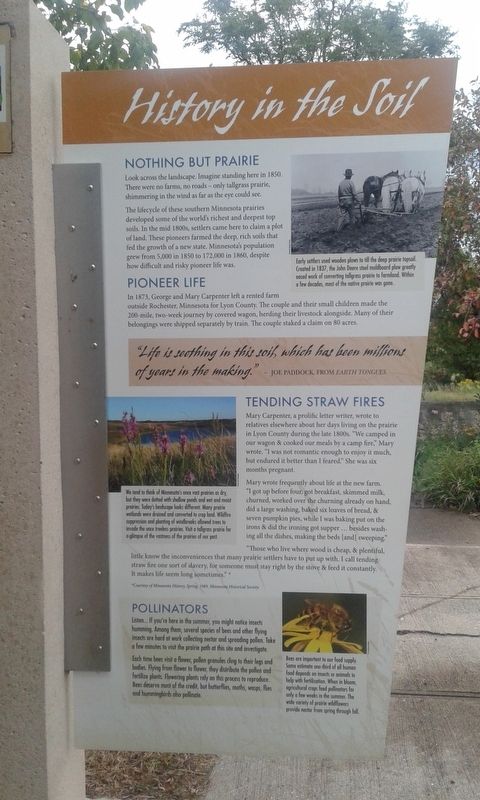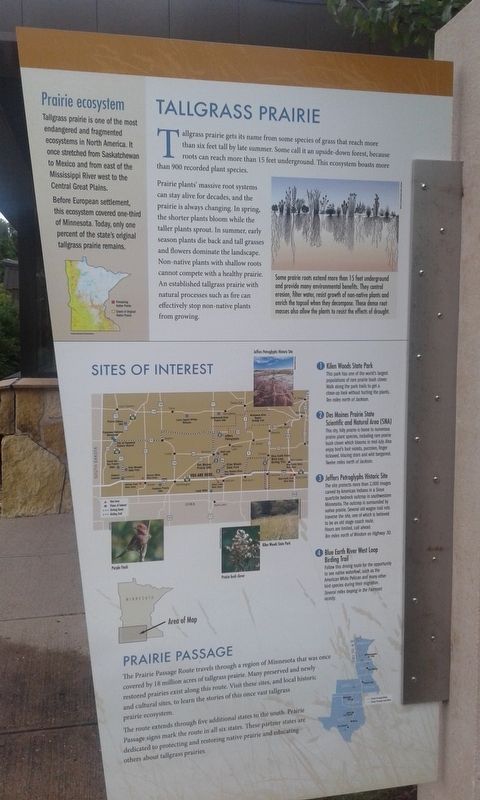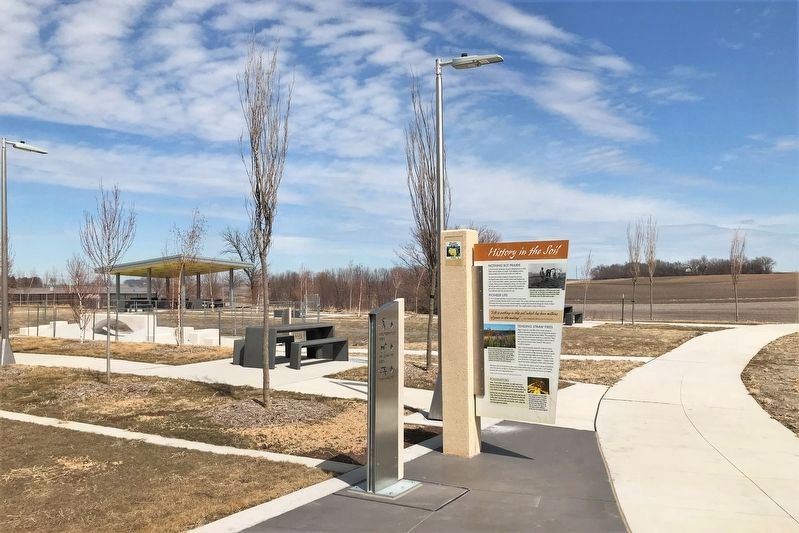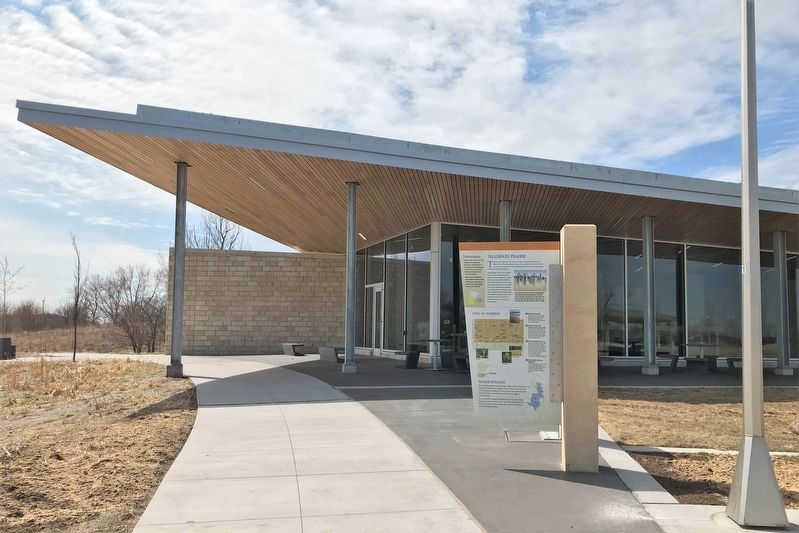Near Jackson in Jackson County, Minnesota — The American Midwest (Upper Plains)
History in the Soil
Look across the landscape. Imagine standing here in 1850. There were no farms, no roads – only tallgrass prairie, shimmering in the wind as far as the eye could see.
The lifecycle of these southern Minnesota prairies developed some of the world's richest and deepest top soils. In the mid 1800s, settlers came here to claim a plot of land. These pioneers farmed the deep, rich soils that fed the growth of a new state. Minnesota's population grew from 5,000 in 1850 to 172,000 in 1860, despite how difficult and risky pioneer life was.
Pioneer Life
In 1873, George and Mary Carpenter left a rented farm outside Rochester, Minnesota for Lyon County. The couple and their small children made the 200-mile, two-week journey by covered wagon, herding their livestock alongside. Many of their belongings were shipped separately by train. The couple staked a claim on 80 acres.
(Caption)
Early settlers used wooden plows to till the deep prairie topsoil. Created in 1837, the John Deere steel moldboard plow greatly eased work of converting tallgrass prairie to farmland. Within a few decades, most of the native prairie was gone.
"Life is seething in this soil, which hat been millions of years in the making." - Joe Paddock, From Earth Tongues
Tending Straw Fires
Mary Carpenter, a prolific letter writer, wrote to relatives elsewhere about her days living on the prairie in Lyon County during the late 1800s. "We camped in our wagon & cooked our meals by a camp fire,” Mary wrote, "I was not romantic enough to enjoy it much, but endured it better than I feared.” She was six months pregnant.
Mary wrote frequently about life at the new farm. "I got up before four, got breakfast, skimmed milk, churned, worked over the churning already on hand, did a large washing, baked six loaves of bread, & seven pumpkin pies, while I was baking put on the irons & did the ironing got supper ... besides washing all the dishes, making the beds [and] sweeping."
"Those who live where wood is cheap, & plentiful, little know the inconveniences that many prairie settlers have to put up with. I call tending straw fire one sort of slavery, for someone must stay right by the stove & feed it constantly. It makes life seem long sometimes."*
*Courtesy of Minnesota History, Spring, 1989. Minnesota Historical Society
(Caption)
We tend to think of Minnesota's once vast prairies as dry, but they were dotted with shallow ponds and wet and moist prairies. Today's landscape looks different. Many prairie wetlands were drained and converted to crop land. Wildfire suppression and planting of windbreaks allowed trees to invade the once treeless prairies. Visit a tallgrass prairie for a glimpse of the vastness of the prairies of our past.
Pollinators
Listen... If you're here in the summer, you might notice insects humming. Among them, several species of bees and other flying insects are hard at work collecting nectar and spreading pollen. Take a few minutes to visit the prairie path at this site and investigate.
Each time bees visit a flower, pollen granules cling to their legs and bodies. Flying from flower to flower, they distribute the pollen and fertilize plants. Flowering plants rely on this process to reproduce. Bees deserve most of the credit, but butterflies, moths, wasps, flies and hummingbirds also pollinate.
(Caption)
Bees are important to our food supply. Some estimate one-third of all human food depends on insects or animals to help with fertilization. When in bloom, agricultural crops feed pollinators for only a few weeks in the summer. The wide variety of prairie wildflowers provide nectar from spring through fall.
(Side 2)
Tallgrass Prairie
Tallgrass prairie gets its name from some species of grass that reach more than six feet tall by late summer. Some call it an upside-down forest, because roots can reach more than 15 feet underground. This ecosystem boasts more than 900 recorded plant species.
Prairie plants massive root systems can stay alive for decades, and the prairie is always changing. In spring, the shorter plants bloom while the taller plants sprout. In summer, early season plants die back and tall grasses and flowers dominate the landscape. Non native plants with shallow roots cannot compete with a healthy prairie. An established tallgrass prairie with natural processes such as fire can effectively stop non-native plants from growing.
(Caption)
Some prairie roots extend more than 15 feet underground and provide many environmental benefits. They control erosion, filter water, resist growth of non-native plants and enrich the topsoil when they decompose. These dense root masses also allow the plants to resist the effects of drought.
Prairie ecosystem
Tallgrass prairie is one of the most endangered and fragmented ecosystems in North America. It once stretched from Saskatchewan to Mexico and from east of the Mississippi River west to the Central Great Plains.
Before European settlement, this ecosystem covered one-third of Minnesota. Today, only one percent of the state's original tallgrass prairie remains.
Sites of Interest
1 Kilen Woods State Park
This park has one of the world's largest populations of rare prairie bush clover. Walk along the park trails to get a close-up look without hurting the plants.
Ten miles north of Jackson.
2 Des Moines Prairie State Scientific and Natural Area (SNA)
This dry, hilly prairie is home to numerous prairie plant species, including rare prairie bush clover which blooms in mid-July. Also enjoy bird's foot violets, puccoon, finger tickseed, blazing stars and wild bergamot.
Twelve miles north of Jackson.
3 Jeffers Petroglyphs Historic Site
The site protects more than 2,000 images carved by American Indians in a Sioux quartzite bedrock outcrop in southwestern Minnesota. The outcrop is surrounded by native prairie. Several old wagon trail ruts traverse the site, one of which is believed to be an old stage coach route.
Hours are limited, call ahead.
Ten miles north of Windom on Highway 30.
4 Blue Earth River West Loop Birding Trail
Follow this driving route for the opportunity to see native waterfowl, such as the American White Pelican and many other bird species during their migration.
Several miles looping in the Fairmont vicinity.
Prairie Passage
The Prairie Passage Route travels through a region of Minnesota that was once covered by 18 million acres of tallgrass prairie. Many preserved and newly restored prairies exist along this route. Visit these sites, and local historic and cultural sites, to learn the stories of this once vast tallgrass prairie ecosystem.
The route extends through five additional states to the south. Prairie Passage signs mark the route in all six states. These partner states are dedicated to protecting and restoring native prairie and educating others about tallgrass prairies.
Topics. This historical marker is listed in these topic lists: Agriculture • Environment • Settlements & Settlers. A significant historical year for this entry is 1850.
Location. 43° 38.117′ N, 95° 4.983′ W. Marker is near Jackson, Minnesota, in Jackson County. Marker can be reached from Interstate 90 at milepost 69,, 4˝ miles east of State Highway 86, on the right when traveling east. Located at the eastbound Clear Lake Rest Area on Interstate 90. Touch for map. Marker is in this post office area: Jackson MN 56143, United States of America. Touch for directions.
Other nearby markers. At least 7 other markers are within 15 miles of this marker, measured as the crow flies. Government Ditches (approx. 3.2 miles away); Olson-Slaabakken Cabin (approx. 4.9 miles away); Olson Slaabakken Cabin / The Jackson County Massacre Monument (approx. 4.9 miles away); Jackson County Massacre Monument (approx. 4.9 miles away); Marble Cabin (approx. 11.2 miles away in Iowa); State Line Congregation (approx. 12.9 miles away in Iowa); Breck Mission and Farm College (approx. 14˝ miles away).
Credits. This page was last revised on April 23, 2022. It was originally submitted on December 6, 2020, by Craig Doda of Napoleon, Ohio. This page has been viewed 165 times since then and 23 times this year. Photos: 1, 2. submitted on December 6, 2020, by Craig Doda of Napoleon, Ohio. 3, 4. submitted on April 23, 2022. • Bill Pfingsten was the editor who published this page.



